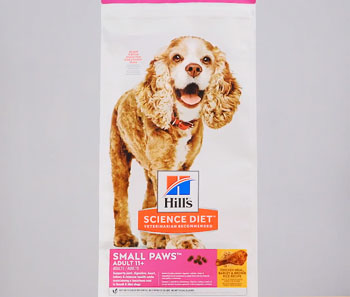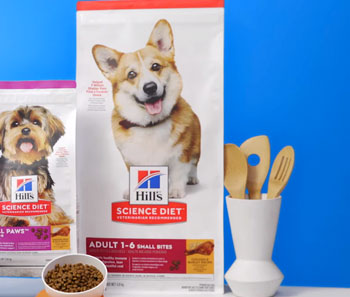When it comes to feeding your small breed dog, you want to make sure you are providing them with the best nutrition possible. Two popular options from Hill’s Science Diet are their Small Paws and Small Bites formulas.
But what exactly is the difference between these two foods? Here is a comprehensive overview comparing Hill’s Science Diet Small Paws and Small Bites to help you determine which is the better choice for your pup.
A Brief Comparison Table
| Feature | Hill’s Science Diet Small Paws | Hill’s Science Diet Small Bites |
| Nutrient profile | Formulated for dogs under 25 lbs | For dogs under 20 lbs |
| Kibble size | Small, easy to pick up | Tiny, bite-sized |
| Primary protein source | Chicken | Chicken and pork |
| Gluten-free | Yes | No |
| Omega fatty acids | DHA from fish oil | DHA from fish oil |
| Antioxidants | Vitamin C and E | Vitamin C and E |
| Calcium levels | Controlled for small dogs | Controlled for small dogs |
| Natural prebiotic fiber | Yes | Yes |
| Texture | Crunchy | Crunchy |
| Calorie content | 361 kcal/cup | 408 kcal/cup |
| Feeding guidelines | Up to 1 cup/day for adult dog | Up to 1 cup/day for adult dog |
Overview of Hill’s Science Diet Small Paws

- Specifically formulated for small breed dogs under 25 lbs
- Features smaller, easy to pick up kibble pieces
- Made with chicken as the #1 ingredient
- Contains natural prebiotic fiber for digestive health
- Enriched with DHA from fish oil for brain development
- Fortified with controlled calcium and phosphorus levels
- Free of artificial colors, flavors, and preservatives
- Provides antioxidant benefits of vitamins C and E
- Crunchy texture helps clean teeth and control tartar
- 361 calories per cup to help manage weight
Overview of Hill’s Science Diet Small Bites
- Designed for small dogs under 20 lbs
- Tiny, bite-sized kibble for little mouths
- Made with chicken and pork as the first ingredients
- Has natural prebiotic fiber for digestion
- Provides DHA from fish oil for brain support
- Calcium and phosphorus levels tailored for small breeds
- No artificial colors, flavors, or preservatives
- Antioxidant benefits from vitamins C and E
- Crunchy kibble helps clean teeth
- Higher calorie density at 408 calories per cup
Also Read: Is TLC Dog Food Better Than Royal Canin?
Key Differences Between Small Paws and Small Bites
When it comes to Hill’s Science Diet formulas for small breed dogs, their Small Paws and Small Bites recipes share many similarities but also have some key differences to consider.
Both foods are designed with the unique nutritional needs of small dogs in mind. They have controlled mineral levels, antioxidant support, prebiotic fiber, DHA, and no artificial ingredients. The kibble sizes are also suited for little mouths.
However, there are several notable differences between Small Paws and Small Bites:

Intended Weight Range
- Small Paws is formulated for dogs under 25 lbs
- Small Bites is tailored for dogs under 20 lbs
So Small Paws covers a slightly higher weight bracket. This means Small Bites may be better suited for tiny toy breeds, while Small Paws accommodates small dogs up to around 25 lbs.
Gluten-Free Status
- Small Paws is gluten-free
- Small Bites contains gluten
For dogs with grain sensitivities or gluten intolerance, Small Paws is the better choice as it avoids all gluten ingredients.
Protein Sources
- Small Paws uses chicken as the sole animal protein
- Small Bites contains both chicken and pork
While both use chicken, Small Bites also incorporates pork as an additional protein. This provides more variety and amino acid balance.
Calorie Content
- Small Paws has 361 calories per cup
- Small Bites provides 408 calories per cup
The Small Bites recipe is more energy dense, making it a good option for highly active small dogs or those needing to gain weight. Small Paws may suit less active pups or dogs prone to obesity.
Kibble Size
- Small Paws has small, easy to pick up pieces
- Small Bites uses tiny, bite-sized kibbles
The extra small kibble of Small Bites is tailored for the tiniest toy breeds. Small Paws works for dogs able to handle slightly larger pieces.
Small Paws may be preferable for gluten-sensitive dogs, less active/overweight prone pups, and breeds up to 25 lbs. Small Bites suits tiny toy breeds under 20 lbs who are highly active or need extra calories. Consider your own dog’s needs and preferences when choosing between the two.
Also Read: Comparison Between TLC Dog Food And Blue Buffalo.
Frequently Asked Questions (FAQs)
The main differences between Hill’s Science Diet Small Bites and Small Paws are: Small Bites is for dogs under 20 lbs, while Small Paws is for dogs under 25 lbs, Small Bites contains gluten, but Small Paws is gluten-free, Small Bites uses chicken and pork as protein sources, Small Paws just uses chicken, Small Bites has a higher calorie density at 408 kcal/cup versus 361 kcal/cup in Small Paws, Small Bites has tinier kibble pieces tailored for toy breeds.
Hill’s Science Diet Small Paws is a dry dog food formulated specifically for small breed dogs weighing less than 25 lbs. Key features include: Smaller kibble size for little mouths, Made with chicken as the sole protein source, Natural prebiotic fiber for digestion, Enriched with DHA and controlled calcium/phosphorus, Free of gluten and artificial ingredients, Antioxidant support from vitamins C and E, 361 calories per cup for weight management, It provides complete, balanced nutrition tailored to the needs of small dogs.
Hill’s Science Diet is generally considered a good quality dog food brand. Some benefits include: Formulas designed for specific life stages, sizes, and health conditions, Extensive research goes into their recipes, Made with high quality natural ingredients, No artificial colors, flavors or preservatives, Good control of mineral levels for bone health, Added vitamins, antioxidants, and fatty acids, Easily digestible recipes, Kibble provides dental benefits, However, some downsides are the use of corn, wheat, and soy in some recipes and the high price. But overall, it is a nutritionally balanced and high quality dog food.
Compared to regular puppy food, small breed puppy formulas have: Smaller kibble size for tiny mouthsHigher protein levels to fuel their rapid growth, More calories and fat for the higher energy needs of small puppies, Tailored calcium and phosphorus levels to control bone growth, Certain nutrients to support brain development, Ingredients selected for easy digestion, Antioxidants for immune system support, So small breed puppy foods provide customized nutrition based on the unique needs of growing small pups.
Also Watch This Review Video:
Final Thoughts
When it comes to feeding small dogs, Hill’s Science Diet offers two great options in their Small Paws and Small Bites formulas. Both provide complete nutrition tailored for small breeds.
Small Paws may be better for gluten-sensitive pups, less active dogs, and breeds up to 25 lbs. Small Bites suits high energy toy breeds under 20 lbs.
Also Read: Comparison Between World’s Best Cat Litter and sWheat Scoop
Consider your individual dog’s health, activity level, age, and preferences when choosing between these excellent recipes. With their research backing and customized nutrition, you can feel confident feeding either Hill’s Science Diet formula to your beloved small dog.
